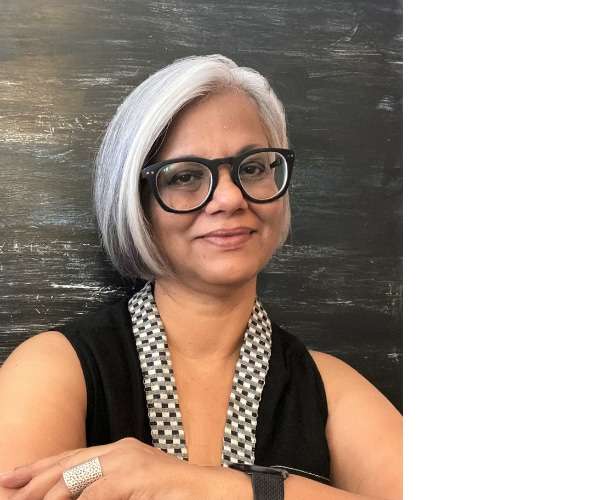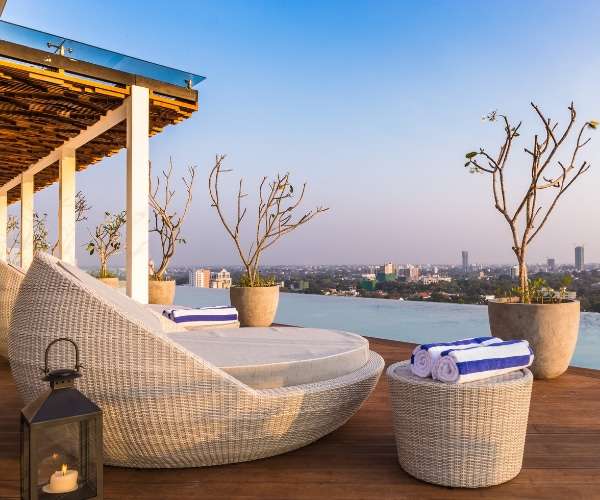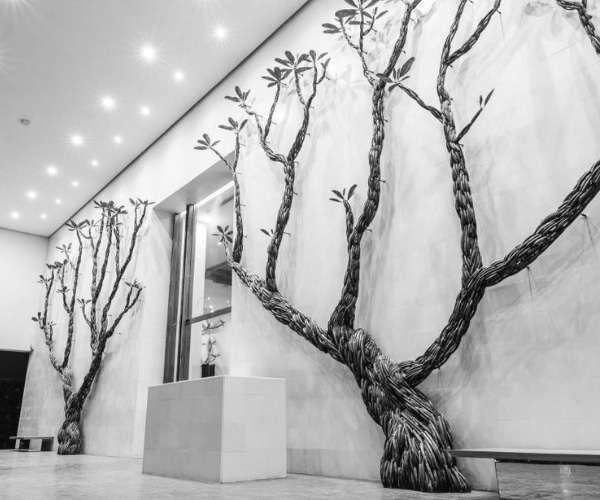
Jan 07 2021.
views 1240Drawing parallels between traditional crafts and architecture and exploring the challenges both face in this age of extreme consumerism, as well as speed and scale of development, Ruchi Jeyanathan talks about the practice of keeping detail-oriented conversations alive through the semantics of construction, an open ear to available elements, bringing the right craftsmen on board and marrying craft and technology. A practising architect and interior designer Ruchi Jeyanathan originally hailing from India graduated from the School of Planning and Architecture, New Delhi, where she started her career in architectural practice before relocating to Sri Lanka in the early 90s. She counts over twenty years of active practice in Sri Lanka, is a director and Head of Design at The Contemporary Design Studio Pvt Ltd. and a self-confessed ‘disruptor’ of design and process-oriented conversations in architecture.

With western influence rampant in all spheres, how do we preserve traditional architectural features?
Technology and lifestyles have given access to the same information and influences, especially visual, across the globe. While this has created exciting opportunities in many different ways, it is important to understand our own unique identity and how it relates to the rest of the world. So coming back to your question, I think rather than preserve specific architectural features, we need to understand the concepts, resources and crafts behind the traditional architecture and even specific features that continue to speak to our souls. Then explore how these relate to present times and adapt them in a relevant way – to keep our own unique culture and tradition alive.
One instance where this kind of transformation is very apparent – is in the adaptation of the traditional courtyard with time from that in the original Jaffna homes, to the early colonial buildings of the Portuguese and Dutch in Galle, to the subsequent Wallauwas and now in contemporary homes. The materials and form of elements used and the way the interior spaces relate to the courtyard have changed, but the essence of providing light and ventilation and often a place for reflection and connection to divinity is a constant through all these iterations of the courtyard.
How do we make traditional architecture relevant in today’s context?
Traditional architecture of any place evolved over centuries in response to climate, culture and resources. There is a wealth of wisdom embedded in it and many lessons which can guide us to respond from our own unique sensibilities, values and physical context, in creating architecture that is reflective of our unique identity. To do this we have to keep our conversations alive around the essence of what informed and influenced traditional architecture, and how that relates to the way we live and work now. At the same time, I believe we need to preserve some aspects or examples of traditional architecture, lest we lose our heritage completely to this rapid pace of change. We can do this by adapting examples of traditional architecture to new uses. And also by using old craft elements in new ways. Again, taking the example of the internal courtyard – it is one element that has been debated, reviewed and spoken about constantly. The conversation around it continues to date and challenges us to constantly rethink our position.
Sri Lanka has many craft forms, from batik and weaving to sculpture and art, what can we do to encourage more youngsters to take up those artisanal crafts as full-time employment options?
The most important thing we can do is create opportunity by using our own local arts and crafts, as much as possible. But I also believe that the youth will engage better with them if these art and craft forms are made more relevant to the current times. There is a huge gap of understanding between the demands of the emerging marketplace and the response of traditional craftsmen.
That’s where design plays an important role. It can be that bridge between the marketplace and the craftsman and it can direct cultural transitions in a responsible, respectful and sustainable way.
Education plays a key role in preserving our heritage crafts which are on the decline. However our school curricular are devoid of such subjects. What steps can the government sector and the private sector take to reverse this decline?
I totally agree with you here. Our youth have little awareness of our heritage and culture and certainly very little understanding of its value. A very effective way of creating this awareness is by creating platforms for the youth to be exposed to and create conversations around good examples and exponents of our crafts and culture, including heritage crafts, dance, music, film etc.
I think the creative community needs to take the lead here, supported by the private and public sector – to re-engage our youth with our the best of our cultural heritage simply by giving them easy access to the best – carefully curated concerts, exhibitions and expositions, subsidised for the youth.

How big a role does sustainability play in the Sri Lankan craft industry in the current climate?
Sustainability is not an alien concept in heritage crafts – most crafts developed over centuries to address conservation of resources, reduce wastage and nurture the natural environment. However, its relevance in the national and global context and how it specifically relates to the practice of traditional crafts in the current context is now being examined in the crafts industry. We need more information to be shared with the industry and platforms for knowledge sharing and collaboration on sustainability.
The biggest challenge to the sustainability of the craft though lies in its evolution and relevance in changing times. There are some excellent examples where these crafts have been adapted through design and value addition to stay relevant to contemporary life. The design revolution around weaving and batik in the fashion industry, at all levels is commendable. I was so happy when a friend visiting from India had purchase of Sri Lankan modern handloom sarees on her list of things to do here!
Careers in design and craft are perceived as less superior than the traditional occupations of lawyers, doctors and engineers. How can we persuade parents to support their children who want to follow careers in design and craft?
By engaging the public in conversations with design practitioners and craftsmen and women. By sharing the thoughts, processes and opportunities in design and craft – which influence the direction of our growth as a nation. These interactions will help them understand the true value of design and craft in the current context and the future.
But as a parent, I think we have to address the youth and once they are convinced themselves about a path in these fields, they will be best placed to convince their own parents.
You are a self-confessed disruptor of design and process-oriented conversations in architecture. How would you encourage other young students in your field to follow your lead?
I am by nature an extremely curious person. I need to understand what drives that which is before me. My mind is always plagued by WHY and WHY NOT. Unfortunately, our culture does not encourage an inquisitive mind. So I would encourage all youth to actively nurture your own curiosity, for it can be a great teacher. It’s a particularly important trait for creative minds. Question everything – it will help you understand what's around you better and open your mind to new possibilities.
With the entire world in lockdown, people changed their consumer habits by buying less, in a change from an age of extreme consumerism. How will this affect the craft and design industry?
I think the best thing that has emerged from this pandemic is the realisation of how little we truly need to consume and how much our over-consumption is harming our planet. Not only for design and crafts but every industry. It's important for us to examine the true value of what we consume by factoring its ecological impact on the planet.
So it’s established beyond doubt that we have to consume less, but if we take into account the hidden value of its ecological impact and pay fair value for it – all beneficial industries will thrive and grow in a sustainable way. In the simple mathematical computation of hard costs of consumer goods, we’ve lost our understanding of value. We need to develop a holistic way of determining value and that should determine price, not ‘cost’ alone.

What positive impacts will programmes such as Design Katha have on the creative community?
These programmes help keep important conversations alive, constantly re-examining our culture and direction. They create platforms for interaction between designers and crafts industry – from so many fields. Finally, these programmes will help bridge that gap of understanding between the creative industries and the lay public.
0 Comments